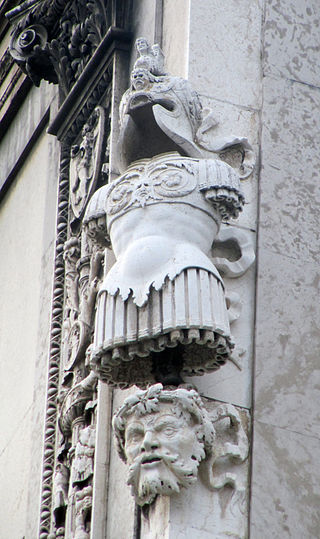
The province of Brescia is a province in the Lombardy region of Italy. It has a population of some 1,265,964 and its capital is the city of Brescia.

Angelo Maria Querini or Quirini was an Italian Cardinal of the Roman Catholic Church.

The early Christian imperial basilica of the Saints Martyrs Vitale, Valeria, Gervasio and Protasio known more commonly as the basilica of San Vitale and Compagni Martiri in Fovea or more simply as San Vitale al Quirinale. It is the oldest Catholic place of worship in the historic center of Rome, located in via Nazionale. The imperial basilica of San Vitale al Quirinale, built under the pontificate of Pope Siricius after 386 and consecrated and richly decorated by Pope Innocent in 402 is the first public Christian basilica with a baptistery not founded on pre-existing pagan temples, mentioned in the Liber pontificalis, built by the Emperor Theodosius at the behest of Saint Ambrose of Milan, in honor of the miraculous discovery of the bodies of martyrs Gervasius and Protasius in Milan. It is the most frescoed basilica in Rome.

The Archdiocese of Turin is a Latin Church ecclesiastical territory of the Catholic Church in Italy.

Ottavio Amigoni was an Italian painter of the Baroque period, active in Brescia. He was trained by Antonio Gandini. Among his masterpieces is a large fresco about the life of Sant'Alberto in the Carmelite church of Brescia, painted with Gandino's son, Bernardino.

The Diocese of Foligno is a Latin Church ecclesiastical territory or diocese of the Catholic Church in Umbria, Italy. It is a suffragan diocese in the ecclesiastical province of the metropolitan Archdiocese of Perugia-Città della Pieve.

The Diocese of Belluno-Feltre is a Latin diocese of the Catholic Church located in the Veneto, northern Italy, organized in its current form in 1986. From 1197 to 1762, and again from 1818 to 1986, the Diocese of Belluno and the Diocese of Feltre were united under a single bishop, with the name diocese of Belluno e Feltre. The current diocese is a suffragan of the Patriarchate of Venice.
Hoste da Reggio was an Italian composer of the Renaissance, active in Milan and elsewhere in northern Italy. He was well known for his madrigals, which were published in several collections in Venice.

Federico Visconti (1617–1693) was an Italian Cardinal and Archbishop of Milan from 1681 to 1693.
Luigi Firpo was an Italian historian and politician.

Gasparo Cairano, also known as Gasparo da Cairano, de Cayrano, da Milano, Coirano, and other variations, was an Italian Renaissance sculptor.

Santa Maria Annunziata is the main religious building (duomo) of the town of Salò, Italy.
Antonio della Porta, better known as Tamagnino was an Italian sculptor of the Renaissance.
Gasparo Antonio Turbini was an Italian architect and Jesuit priest, mainly active in a Neoclassical-style in the Province of Brescia, Italy.

Brescia is a city and comune in the region of Lombardy, in Italy. It is situated at the foot of the Alps, a few kilometers from the lakes Garda and Iseo. With a population of more than 200,000, it is the second largest city in Lombardy and the fourth largest in northwest Italy. The urban area of Brescia extends beyond the administrative city limits and has a population of 672,822, while over 1.5 million people live in its metropolitan area. The city is the administrative capital of the Province of Brescia, one of the largest in Italy, with over 1,200,000 inhabitants.
The following is a timeline of the history of the city of Brescia in the Lombardy region of Italy.

The Ark of Sant'Apollonio is a funerary monument in marble by Gasparo Cairano. Dated between 1508 and 1510, it is located in the third chapel on the right of the southern nave of the New Cathedral, Brescia.

The Altar of San Girolamo is a sculptural complex in marble, around 780×450×80cm in dimension, designed and constructed by Gasparo Cairano and Antonio Medaglia, and situated within the Church of St Francis of Assisi in Brescia, Italy. Dated between 1506–1510, it is located in the first chapel on the right side of the nave.
Marco Loredan (1489-1557) was a Venetian nobleman, senator and politician of the Loredan family, as well as Count of Brescia, Feltre, Rovigo, Salò and Famagusta, presiding over a time of famine and poverty following the War of the League of Cambrai.
Gerardo da Sesso was an Italian monk, bishop and cardinal of the Catholic Church.














